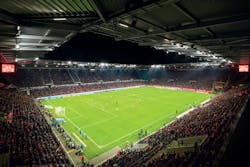Sports SSL: Thorn lights arenas, LEDiL designs sports-specific LED optics
Thorn Lighting (a Zumtobel business unit) has announced the LED-based lighting of professional football/soccer pitches on both sides of the Atlantic Ocean in venues that play host to top-level competition. LEDiL has announced an optics family specifically designed for lighting sports venues with a variety of beam patterns and minimal low-angle glare.
Lighting of pro sports playing surfaces was a difficult challenge for proponents of solid-state lighting (SSL) during the early stages of the LEDification process. Until about five years ago, LED-based fixtures could not deliver the needed lumen output in a reasonable form factor. Commencing with the 2015 National Football League (NFL) Super Bowl, the landscape changed considerably. A year later, we saw Major League Baseball (MLB) teams began to retrofit ballparks with LED lighting. And we’ve covered numerous projects at soccer venues around the globe.
Thorn soccer projects
Most recently, Thorn has announced two major soccer projects. The company supplied a retrofit project at the Opel Arena in Mainz, Germany that is home to the FSV Mainz 05 Football Club. And the company also supplied a project at the La Bombonera venue in Buenos Aires, Argentina that also had to meet the requirements of the South American Football Confederation (CONMEBOL) to be used in the Copa Libertadores and Copa America tournaments.
The Mainz project has served the team for the just ended Bundesliga season that was interrupted by coronavirus. The project includes 220 Thorn Altis floodlights and a comprehensive DMX control system. And like most sports-lighting projects, the requirements were as much driven by the needs of HDTV broadcasts as for players or fans in the stands. The 5700K-CCT luminaires feature a CRI of 86 and a TLCI (Television Lighting Consistency Index) rating greater than 80. As we covered in a recent story, TLCI was developed by the European Broadcast Union.
The Argentina project was also dictated by HDTV needs. Thorn delivered 248 Altis luminaires that produce horizontal illuminance levels greater than 2000 lx, and vertical levels greater than 1300 lx. Thorn said the new system delivers double the light levels of the prior system while consuming 30% less energy. Thorn has also developed a guide to such lighting called “Sports Lighting: Better Light. Better Plays.” That guide is available on the company website.
LEDiL optics
Moving to the LEDiL optics story, the availability of custom optics is certainly indicative of the fact that LED lighting of sports venues has gone mainstream. And like Thorn, LEDiL has developed a guide to the sports-lighting application.
The LEDiL Sport-2×2 optic, as the name implies, is intended to fit over a four-LED array. The optic works with 3.5×3.5- or 5.0×5.0-mm LEDs. The optic was designed for use with a flat LED emitting surface that does not include a domed primary optic. The optic itself measures 50×50 mm.
With the new family, LEDiL supports venue lighting of both outdoor facilities such as soccer and indoor multi-purpose athletic facilities. That flexibility comes via the variety of beam patterns in the portfolio. The list includes symmetric and asymmetric patterns and in all cases the optics minimize unintended light trespass.
LEDiL believes such LED optics variety is the only viable path forward for lighting companies that want to serve the plethora of different facility types used for everything from recreational departments to professional sports team. The choices enable designers/specifiers to optimize lighting for players, officials, and fans and ensure minimal impact on the environment.
For up-to-the-minute LED and SSL updates, why not follow us on Twitter? You’ll find curated content and commentary, as well as information on industry events, webcasts, and surveys on our LinkedIn Company Page and our Facebook page.

Maury Wright | Editor in Chief
Maury Wright is an electronics engineer turned technology journalist, who has focused specifically on the LED & Lighting industry for the past decade. Wright first wrote for LEDs Magazine as a contractor in 2010, and took over as Editor-in-Chief in 2012. He has broad experience in technology areas ranging from microprocessors to digital media to wireless networks that he gained over 30 years in the trade press. Wright has experience running global editorial operations, such as during his tenure as worldwide editorial director of EDN Magazine, and has been instrumental in launching publication websites going back to the earliest days of the Internet. Wright has won numerous industry awards, including multiple ASBPE national awards for B2B journalism excellence, and has received finalist recognition for LEDs Magazine in the FOLIO Eddie Awards. He received a BS in electrical engineering from Auburn University.





